Gravity
Gravity is described as an attractive force between masses. It is the
oldest known and most well-observed of the known forces. Yet often
considered the least understood.
As far back as 1676 Isaac Newton described gravity via an equation that
stated its force was proportional to the product of two masses and
inversely proportional to the distance between them. This much could he
could confirm from the motion of planets and other astronomical bodies
and the behaviour of objects on Earth. But what Newton could not be
sure of was why gravity behaved as it did or why it occurred at all. He
later wrote “I have not been able to discover the cause of
those properties of gravity from phenomena, and I frame no hypotheses
...”.
Since that time, little else has been learned about the nature of
gravity other than it appears to propagate at light speed, based on
observations of mercury’s
perihelion.
So what could be the mechanism behind gravity? Yes we understand it to
be a force between masses, but how does mass ‘communicate’ such a
force? Based on the inverse square relationship and its limited
propagation speed it seems that gravity propagates as a field – much
like an electric field, except generated by mass rather than charge and
always attractive. It’s as if every subatomic particle radiates a field
with strength proportional to its mass. That field then spreads
spherically outward at light speed, weakening as it goes with
inverse-square strength.
The fact that a gravity field moves at light speed raises some
interesting questions. When that field strikes another mass it applies
a force in the opposite direction. This sounds somewhat similar to the
attractive force between oppositely charged particles. As explained
throughout this book, such as with magnetism,
there is ample reason to believe that electric forces are based, not
only on charge and distance alone, but also velocities. Therefore one
might wonder whether gravity might work in a similar way also. For
example would gravity increase as an object moves away from another
mass, like an electron moving away from a proton? And would gravity
decrease as an object moved toward another, falling to zero as the
incoming object approached light speed?
Electrical effects of Gravity?
Such questions are interesting. But
rather than speculate on simple points like that, it would be more
helpful to understand gravity on a more detailed level. Earlier on we
saw how magnetism between two wires could be explained in terms of
neutral charge movements. The two wires were electrically neutral yet
were able to exert a net attraction or repulsion on each other. A
similar phenomenon occurs with static
electricity in which charged objects are able to attract
neutral objects, even when such objects cannot be “polarised” according
to the theory of how static electricity is said to operate. Therefore
one might wonder if similar motion-based electrical effects might be
responsible for gravity.
Of course there are great differences between gravity and magnetism.
For one, the gravitational force is extremely weak and only becomes
noticeable when dealing with large clumps of neutral matter, usually
astronomical bodies. Secondly, gravity is always attractive and has no
‘poles’.
Those quarks again
In the preceding chapters we looked
at atomic nuclei as being active arrangements of moving quarks. It that
model, positive up-quarks orbited negative down-quarks and embedded
electrons. This motion was sufficient to explain the strong nuclear
force and possibly the quantum mechanical nature of electron orbits.
Could it have any effect beyond these things? Let’s look at a proton
again.
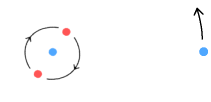
The above diagram shows the simplest
of atoms – hydrogen. The situation is overall neutral with two
up-quarks orbiting a down and an electron at a distance. The aim here
is to determine the overall effect of this movement on similar atoms
nearby. The situation is a bit complex and contains many particles so
let’s simplify it a bit:

Here we have a single up-quark
orbiting a stationary down-quark. Obviously this arrangement is not the
same but since the up-quarks have the same motion we can study the
effects from just one of them. As for the electron, it is moving
relatively slowly compared to the quarks so we can treat it as being
basically stationary like the down-quark. What we’ve effectively done
is combine the up-quarks together and combine the electron into the
down-quark. We’ll start by looking at what effect this will have on a
positive charge.
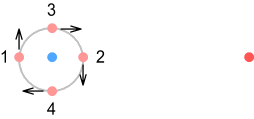
Above we see a positive charge
sitting in the same orbit plane as the up-quark. We’ll look at the
force from four points in the orbit: left, right, top and bottom and
labelled 1,2,3,4 respectively. As the up-quark moves toward the
positive charge (point 3) it exerts an increased force, and as it moves
away (point 4), force decreases. As it moves up and down (points 1 and
2) its force decreases slightly. Doing the math shows the overall
contribution from these points yields a net increase in repulsion. If
we wish to know the contribution from all possible points in the orbit,
this requires integrating around the circle. Doing this shows, as might
be expected, that the overall force has increased and the orbiting
up-quark pushes the positive charge away.
So if quarks orbiting within a proton can increase their push on a
positive charge, what will they do to a negative one? If we replace
that positive charge on the right with a stationary electron we can
calculate the net contribution from all points around the orbit. Due to
the increase in attraction from the positive charge moving away (point
4), it should come as no surprise that net contribution is negative and
the electron will be attracted. This is similar to the net-attraction
described in the static
electricity chapter.
Let’s repeat the above with a bit of math. Consider the diagram below:

On the left is a positive up-quark
closely orbiting a negative down-quark. On the right is a target
particle sitting at a distance of one unit. The up-quark is orbiting in
the same plane as the target. All charges have a unit charge of one,
such that the force between two particles at a unit distance will be
one force unit. We will also say the up-quark is moving at 10 percent
of light-speed, i.e. 0.1c. Here are the
results:
If the target particle is positive it will experience a force of
+0.0325 (repulsive)
If the target particle is negative it will experience a force of
-0.0024 (attractive)
These numbers come from integrating the force around a circle. It seems
the attractive force on the negative target is rather weak by
comparison. This is due to time-decay of the field strength as the
positive up-quark (at point 4) moves away from the target.
Changing orientations
Okay, so we know what happens when
the target particle lies in the same plane as the orbiting up-quark.
What would happen if we turned that orbit plane around? See diagram:

Here the orbit plane is at right
angles to the target particle. Here are the results:
If the target particle is positive it will experience a force of
-0.0344 (attractive)
If the target particle is negative it will experience a force of
-0.0247 (attractive)
This is a very interesting result. Both negative and
positive targets are now being attracted. How did this happen? The
reason is that the up-quark is always moving away from the target so
its virtual-current particle will be located far from the target. This
means it can’t repel the positive target very well and hence we are
left with a net attraction toward the down-quark. But at the same time,
the away-movement is sufficient to cause a net increase on the
attraction of the negative target.
Attraction between two circular
orbits
The above calculations show the net
force exerted on a stationary target particle by an up-quark moving in
different circular orbits. Let’s now extend that to look at the force
between two such orbiting quarks. Start with this situation:
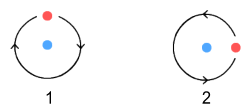
Here we see our two ‘protons’ with
their up-quarks in the same orbit plane. The phase-angle of the quarks
are random and not aligned between the two protons. We wish to know the
net force on the proton on the right. The net force will be the sum of
four force component quark combinations: up2 & up1; up2
& down1; down2 & up1; and down2 & down1 (where
1 and 2 respectively represent the left and right protons).
This gives a net force of +0.03015 (repulsive)
And the two protons repel each other. The above number was calculated
from the average of all possible points on one orbit (of proton 1) to
all possible points on the other orbit (of proton 2).
Now we’ll redo the above but this time with the orbit planes facing
each other (again, the phase between up-quarks is unmatched):
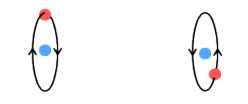
This setup yields a net force of
-0.05930 (attractive)
So this time the protons attract each other.
Going
the full sphere
The above situations show how the
net force between two protons can vary greatly, depending on
orientation. What this tells us is that it’s possible for protons to
reduce the amount of static repulsion that would be predicted by
Coulomb’s law. This means that if we add electrons to neutralise the
situation, i.e. by making atoms, there can be a net attraction between
such atoms, provided that they are suitably aligned.
In reality however, we can’t assume protons to be aligned in specific
orientations. Within a large clump of matter, protons will be randomly
aligned in all manner of directions. Therefore to determine the net
effect from all possible orientations it is necessary to repeat the
above exercises but this time by integrating over the surface of a
sphere. See below:

On the left is our up-quark orbiting
the down-quark in random directions over the surface of a sphere, in
which the pink sphere represents all possible positions of the red
up-quark. On the right is a static target particle. We will consider
the situations where the target is positive and negative.
If the target particle is positive it will experience a force of
+0.010013 (repulsive)
If the target particle is negative it will experience a force of
-0.009853 (attractive)
Just as with circular orbit on the same plane as the target, the
‘spherical’ orbit repels the positive charge and attracts the negative
one. The difference here though is the magnitude of the forces is lower
and they are closer together.
Now take this to the next step, which is to have two spheres. See
diagram:

Here both the source and target
consist of up-quarks orbiting a down-quark. The orbits are circular,
however, since we must consider all possible random orientations, we
treat them as ‘spherical’. Determining the net force in this situation
requires integrating all possible positions over one sphere versus all
possible positions over the other. It’s a four-way integration, and
very complex. But here is the result:
The net force is + 0.0001369 (repulsive)
This is a bit of a disappointment. What it shows is that the average
force between atoms orientated in random directions is repulsive,
rather than attractive. The opposite of gravity. The force between them
is 7300 times weaker than the force between two stationary up-quarks –
which is nice because we are searching for a weak force that might pass
for gravity. Except it’s in the wrong direction.
Cutting a cone
Rather than quit at this point it is
useful to investigate what might have gone wrong or if anything has
been overlooked. The net force we arrived at was a combination of many
factors. It consists of the interaction between different charged
particles moving in different directions. The greatest degree of
repulsion occurs when the positive quarks move directly toward each
other. Therefore it would be interesting to know how much of this
‘direct toward’ motion would need to be removed from the equation to
bring the net force down to zero and into the negative (attractive)
domain.
This can be done by removing a small portion of the ‘sphere’ along the
direction of a line joining our two protons. Basically cutting out a
cone-shaped region from each as shown:

And then saying the up-quarks are
restricted to orbiting within the remaining region. [Note: this diagram
shows a mid cross-section of the cones – the cones don’t cut across the
entire sphere as drawn]
After some experimenting, it can be found that this angle can be as
narrow as 5.47 degrees in total, i.e. a half angle of 2.735 degrees,
for the repulsion to cease and the ‘protons’ to begin attracting. In
this situation the protons will have a net attraction of -2.6x10-7
force units.
The above is certainly interesting because it shows that only a narrow
region of the up-quark motion is responsible for the net repulsion of
our ‘protons’. Therefore it would seem that if we could limit the
motion of the orbiting quarks such that they don’t run directly toward
each other, a weak attractive force would result.
Such alignment might naturally occur within a small clump of protons
because the up-quarks would avoid moving directly toward other
up-quarks, where they experience the maximum degree of repulsion.
Problem is though, a large group of protons, such as would exist within
a planetary body or even a small rock, cannot align themselves to face
each other because they are not arranged in a line and are surrounded
by protons on all sides.
Synchronization is the key?
There may be an answer however. When
calculating the above net forces the assumption was made that quark
movement is random, in that the quark orbits are aligned in random
directions and have no relationship with each other. Well the overall
alignment may well be random from one proton to the next, but the
precise movement of the orbits is another matter.
As an up-quark orbits, it will encounter a certain degrees of both
attraction and repulsion. An attractive force will cause the quark to
speed up and a repulsive force will cause it to slow down slightly. As
shown above, the greatest amount of force will be the repulsion that
occurs when two quarks head directly toward each other. This may cause
an orbiting quark to adjust its orbit such that that force is
minimized. Basically we would expect it to synchronize with the
movement of the other photon and adjust its phase so as to reduce the
overall force to a minimum.
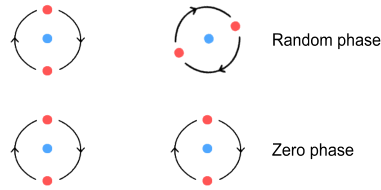
The above diagram shows an
unsynchronized (random phase) situation versus a synchronized (zero
phase) situation. Here the red up-quark has been split into two to
represent the opposing quarks on the same proton and each up-quark is
given a charge of +1/2 (the down-quark still has -1).
By experimenting with phase relationships we find the minimum force
between two protons occurs when the opposing quarks have the same
angle, i.e. the phase between them is zero.
To be specific, the force between the above situations is as follows:
Random alignment: +0.0301496 (repulsive)
Phase-lock alignment: +0.0300678 (repulsive)
We note here that the force is still repulsive but that is has
decreased by an amount of 0.0000818.
Now let’s go back to our two-sphere model, in which the quarks between
opposing protons move at random. In this situation they receive a
repulsion of 0.0001369 units. Now let’s modify that slightly to say the
quark orbits are overall random but when they sit in the same plane
they synchronize with the same phase.
This would reduce the amount of force between them. To calculate the
new force we subtract the above difference and get:
0.0001369 - 0.0000818 = +0.0000551
The force is still repulsive but has reduced substantially. To reduce
it further we could argue that synchronization occurs over a narrow
range when the orbit planes are almost lined up. If that were the case
the net force could shift to negative and the protons (combined with
stationary electrons) would attract. Providing this new level of
attraction was low enough it could pass for the phenomenon we call
gravity.
Cancelling the radiation
There is another reason to believe
why the phase of two proton’s up-quarks should synchronize and why
their phase should be zero.
The model of a single proton presented here has two positive up-quarks
orbiting a negative down-quark. The up-quarks are exactly opposite each
other and each emit a signal that precisely cancels the output of the
other because it is 180 degrees out of phase.
Precisely? Not quite.
It’s true that if the up-quarks are directly opposite this will cause
them to radiate signals that are 180 degrees out of phase, i.e.
opposite, to each other. But the problem is they are not located in the
same place. The up-quarks are located one-behind the other. This means
there will be a short delay for the signal from the farther quark to
reach the nearer one. The below diagram explains this:

Here two electrons are moving in
sinusoidal motion within parallel antennas, shown as black vertical
lines. The voltage signals fed into each antenna are 180 degrees out of
phase, i.e. they are mirror images of other. Now if the antennas were
sitting right next to each other the two signals they generate (shown
in blue) would completely cancel and we would detect nothing to the
right of them. But since there is a distance between them they don’t
completely cancel and we are left with a net signal as shown in red.
The amplitude of the combined wave will depend on the frequency and the
time taken for the signal to pass between the two antennas. Shorter
distances make for better cancellation and higher frequencies lead to
less cancellation.
The proton is an analogous situation because the opposing up-quarks are
one behind the other. This distance between them is very short and
light travels very fast so the time taken for the signal to cross this
gap will likewise be extremely short – but not zero. In addition to
this the high frequency of orbit will reduce the amount of cancellation.
This means the up-quark signals will be slightly less than 180 degrees
out of phase and will radiate a weak high-frequency field, probably in
the high gamma-ray range. If this were the case we would certainly be
aware of it. Except we don’t observe such radiation.
This indicates that the phase between protons has been matched. In
order for a proton to adjust its phase it would either need to adjust
its speed temporarily or reposition itself slightly toward or away from
another proton so as to synchronize with its ‘up-quark waves’. In some
cases the synchronization will be good, in other cases it will be
partial. What matters however is only the overall average because that
is what determines the net force between large clumps of matter. If
that net force is both weak and attractive then it could pass for
gravity.
Anti-gravity at a
distance
There is a problem however with the above idea that synchronisation
must occur between all orbiting quarks. Namely that it would
be not be possible for synchronising to occur over unlimited
distances. For example it would be very difficult for distant
galaxies to synchronise with each other because their fields would be
very weak.
But this problem may well be a blessing in disguise. If
galaxies and galaxy clusters could synchronise they would exert a weak
attraction on each other, and this would pull everything in the
universe
together. But being out of sync means, not only won’t they
attract, they will instead weakly repel each other. It also
means they will slowly accelerate away from each other.
There is a certain body of evidence to suggest that much of the
universe is doing just that. Namely the phenomenon of
redshift which occurs when light-emitting objects move away from each
other [1]. To
explain this physicists came up with the
concept of ‘dark energy’ which is said to be a substance that makes up
75% of the universe and pushes it apart. With the concept of
unsynchronised gravity however, it becomes unnecessary to invent such
substances; ordinary matter can do the job on its own.
No Light-bending or
Singularities
If the idea that gravity is the
result of an interaction between electrical charges (rather than
masses) is true, it has a number of important implications.
Firstly it means that gravity won’t bend light. We know that
laser beams and radio waves pass though each other without
deflection. Therefore a light beam should not be disturbed by
the electrical fields of gravity either. This means that any
such observed bending is more likely the result of refraction as
described in general
relativity experiments.
A second point has to do with the concept of black holes. In
the general
relativity chapter I argued that the time
dilation aspects of such bodies should not occur. And here I
argue that they should not attract light either. But even if
super-massive bodies neither attract light nor distort time, there is
another aspect attributed to black holes that warrants discussion: the
‘singularity’. This is the idea that a massive object can
collapse under its own gravity and into a point.
If gravity operated purely as a force between masses then we could
arguably grow a force without limit. For example, imagine
that we had access to a (very-very-very) large supply of sand and the
ability to transport it to the planet Mars. We begin this
experiment by steadily adding sand to its surface in an even
manner. As time passes Mars grows ever larger and its surface
gravity ever stronger. While this is happening the pressure
at the core of the planet becomes steadily greater. The atoms
at the planet’s core are being held apart by chemical forces, i.e. by
repulsion between their orbiting electrons. This force is
very strong but not infinitely so. At some point, e.g. when
Mars becomes ten thousand times its original diameter, this force will
become overwhelmed by the pressure of gravity.
At this point, speculatively speaking, the atoms might collapse into
their nuclei, making the planet a ‘neutron star’. This
collapsed planet would possibly be a thousand times smaller than its
pre-collapse size giving it even higher surface gravity and higher
internal core pressure. But we don’t stop there – we continue
adding sand to its exterior. At some point the internal
pressure will become so great that even those nuclei cannot withstand
the force. At this point the structure would further
collapse, its gravity increasing as it shrinks, and ultimately into a
single point with infinite surface gravity: a ‘singularity’.
Such an outcome seems impossible because we now have a finite amount of
mass contained in a zero volume. Yet this is precisely what
gravitational laws predict. Seeing that common-sense physics
principles do not allow for division by zero it would therefore be wise
to consider a more-likely outcome of this sand experiment.
So here is another possibility. As the nucleons begin to
collapse the quark orbital structures come apart. Since the
orbital motion of quarks is what causes gravity, at this point gravity
ceases to exist. Instead the entire structure blows itself
apart… a supernova perhaps? In reality this explosion would
probably occur at the earlier point where the nucleons come into
contact with each other since it seems unlikely that quarks could orbit
under such conditions. This would also mean a ‘neutron star’ is
not a valid state for matter either.
Reversing
the charges
Before concluding it is interesting
to note what happens if we were to totally reverse the charges on one
of the protons. That is, make the down-quark positive and the up-quark
negative as shown below:

Integrating over two full spheres,
we can calculate the net force between them to be +0.0004595 (repulsive)
That’s an interesting result because one might suppose that the moving
positive quark on one proton would produce a strong attraction on the
moving negative quark on the other. Instead, not only do they repel,
the repulsion is 3.4 times greater than between identical protons.
Now it is possible to make them attract by ‘cutting a cone’ as per the
above method. But to do this requires the cone angle to be around 10
degrees (a half angle of 5 degrees), which is nearly twice what was
required for the two identical protons.
Hence it does appear unlikely that such opposite protons will be able
to attract. The significance of this will become apparent in the second
chapter on Cosmology.
Conclusion
It’s possible that the phenomenon we
know of as gravity may be due to the interaction between of moving
subatomic particles within nucleons. Particularly the rapid orbit of
up-quarks and the relatively slower down-quarks and electrons.
This does not rule out the possibility that mass also generates a
gravitational field that produces attractive forces on other masses.
However any such force would be in addition to the forces that would
arise from movement of electric forces described here. Therefore it may
be that gravity is a combination from both force types.
The arguments presented in this chapter are largely descriptive and
hence incomplete from a mathematical view-point. A proper proof that
gravity is entirely result of electric forces will require deriving the
gravitational constant G from first principles. Doing so will require
knowing precise information about the size and charge-distribution of
quarks (both types) and even electrons. It will also require huge
amounts of numerical computation and simulation.
An exercise for another day!
[1]
Research from astronomers such as Halton Arp indicates much of this
redshift may be due to factors unrelated to velocity – see
http://www.electric-cosmos.org/arp.htm
As a result it is
difficult to know of the net movement of the universe. In the
later chapter on cosmology I will argue that the net movement is
outwards, although at a much slower rate than presently believed.
|












